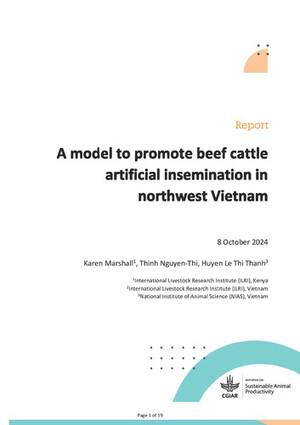
Characterizing lactation curve of indigenous and crossbred cows
Abstract
Initial and peak milk yield, days to peak milk yield and persistency index (PI) of indigenous and crossbred cows were determined to characterized their lactation curve. The study was based on existing data in the Bako Agricultural Research Center and Debre Zeit Research Station. The overall mean initial and peak milk yield, days to peak and PI were 5.5 ± 0.07 kg, 8.2 ± 0.17 kg, 44.0 ± 1.17 days and 86.2 ± 0.70 %, respectively. Crossbred cows had significantly (p < 0.001) higher initial and peak milk yield and longer days to peak than the indigenous breeds. PI, however, was significantly (p < 0.05) higher in Simmental crosses compared to the other sire breeds considered. Among the crossbreeds, the Jersey crosses had significantly the highest initial (7.1 ± 0.24 kg) and peak milk yield (9.9± 0.21 kg) while the Simmental crosses had the longest days to peak (49.4 ± 4.32) and the highest PI (91.4 ± 1.83%). The Horro, as a sire breed, had significantly (p < 0.001) higher initial (3.3 ± 0.25 kg) and peak milk yield (5.5 ± 0.25 kg) than the Boran, while as a dam breed, the Boran had significantly (at least p < 0.01) higher peak milk yield (8.1 ± 0.16 kg) and longer days to peak (46.6 ± 2.22 days) than the Horro. The Debre Zeit herd had significantly (p < 0.01) higher initial (5.1 ± 0.25 kg) and peak milk yield (7.8 ± 0.25 kg), shorter days to peak (33.2 ± 4.39 days) and higher PI (89.2 ± 1.75 %) than the Bako herd. Parity significantly affected (p < 0.001) initial and peak milk yield only. Initial and peak milk yield showed curvilinear trend with parity, both increased till fourth parity and then started to decline. Cows that calved during Gana, Arfasa, Bona and Birra had the highest initial and peak milk yield, longest days to peak and highest PI, respectively. Significantly (at least p < 0.05) highest initial (5.9 ± 0.35 kg) and peak milk yield (8.5 ± 0.32 kg) were observed for cows that calved in 1981 while the longest days to peak milk yield was recorded for cows that calved in 1991 (53.7 ± 8.09 days). Initial and peak milk yield, days to peak milk yield and persistency index (PI) of indigenous and crossbred cows were determined to characterized their lactation curve. The study was based on existing data in the Bako Agricultural Research Center and Debre Zeit Research Station. The overall mean initial and peak milk yield, days to peak and PI were 5.5 ± 0.07 kg, 8.2 ± 0.17 kg, 44.0 ± 1.17 days and 86.2 ± 0.70 %, respectively. Crossbred cows had significantly (p < 0.001) higher initial and peak milk yield and longer days to peak than the indigenous breeds. PI, however, was significantly (p < 0.05) higher in Simmental crosses compared to the other sire breeds considered. Among the crossbreeds, the Jersey crosses had significantly the highest initial (7.1 ± 0.24 kg) and peak milk yield (9.9± 0.21 kg) while the Simmental crosses had the longest days to peak (49.4 ± 4.32) and the highest PI (91.4 ± 1.83%). The Horro, as a sire breed, had significantly (p < 0.001) higher initial (3.3 ± 0.25 kg) and peak milk yield (5.5 ± 0.25 kg) than the Boran, while as a dam breed, the Boran had significantly (at least p < 0.01) higher peak milk yield (8.1 ± 0.16 kg) and longer days to peak (46.6 ± 2.22 days) than the Horro. The Debre Zeit herd had significantly (p < 0.01) higher initial (5.1 ± 0.25 kg) and peak milk yield (7.8 ± 0.25 kg), shorter days to peak (33.2 ± 4.39 days) and higher PI (89.2 ± 1.75 %) than the Bako herd. Parity significantly affected (p < 0.001) initial and peak milk yield only. Initial and peak milk yield showed curvilinear trend with parity, both increased till fourth parity and then started to decline. Cows that calved during Gana, Arfasa, Bona and Birra had the highest initial and peak milk yield, longest days to peak and highest PI, respectively. Significantly (at least p < 0.05) highest initial (5.9 ± 0.35 kg) and peak milk yield (8.5 ± 0.32 kg) were observed for cows that calved in 1981 while the longest days to peak milk yield was recorded for cows that calved in 1991 (53.7 ± 8.09 days).
Citation
Ethiopian Journal of Animal Production; 3(1): 37-52.









